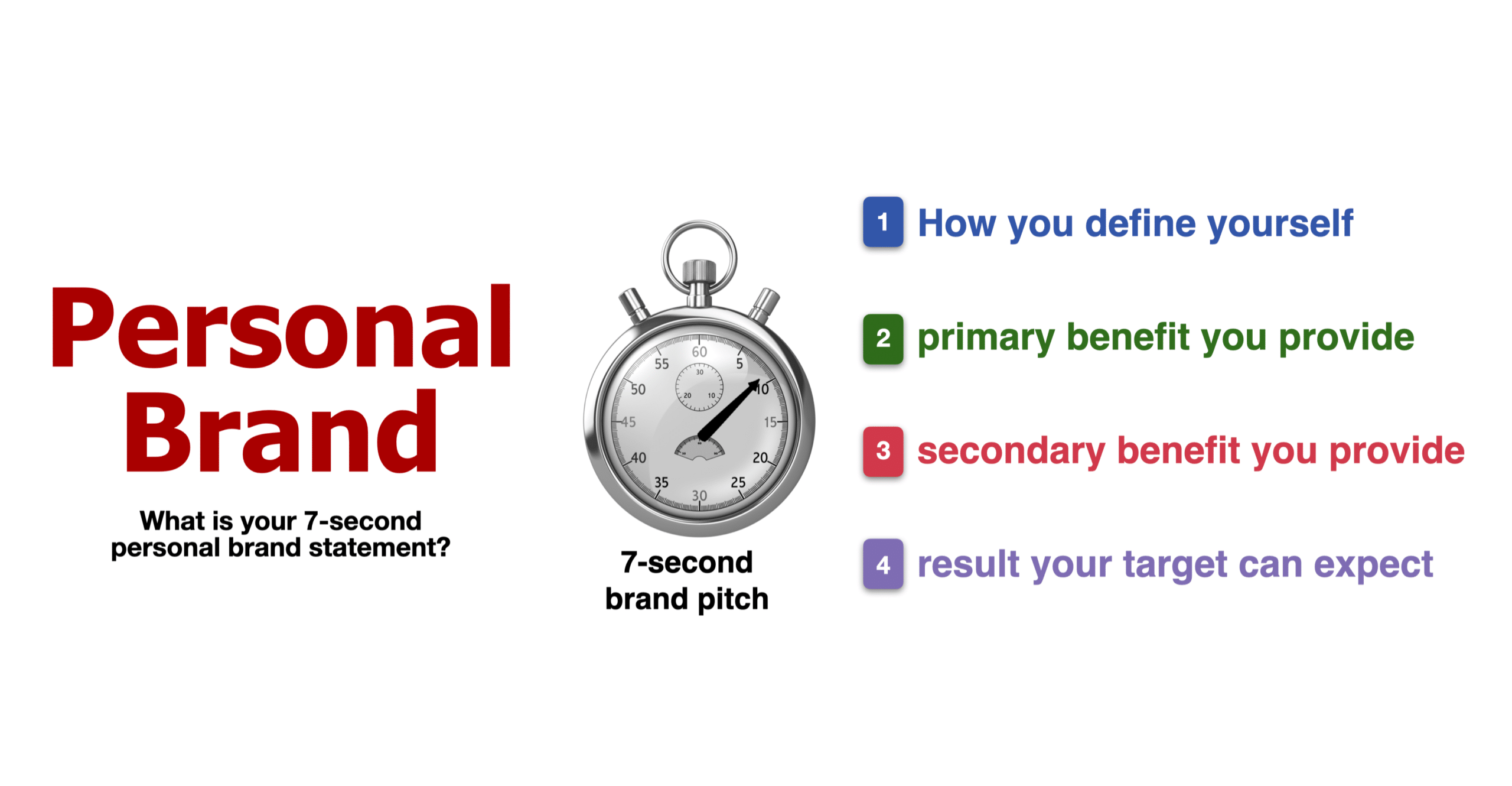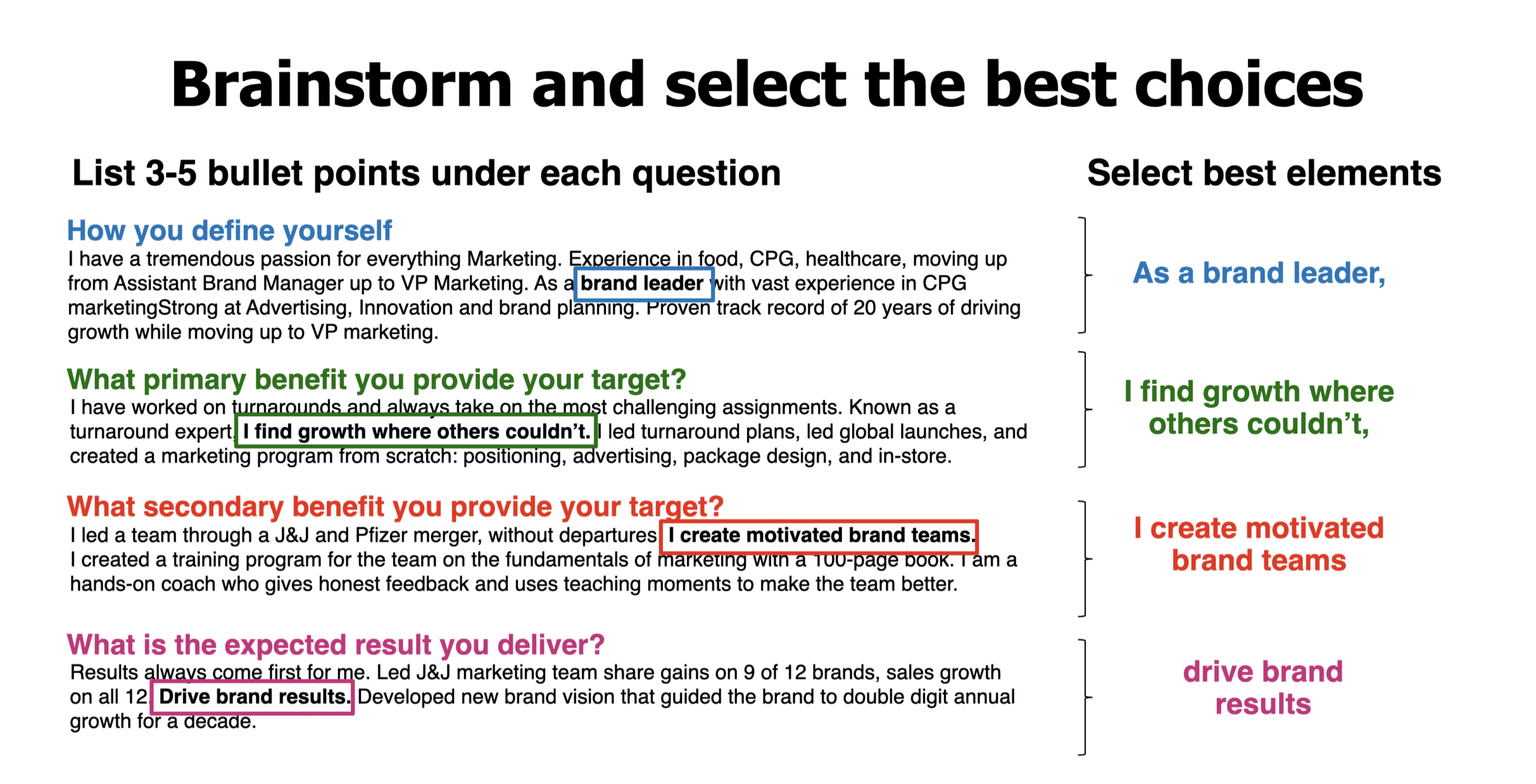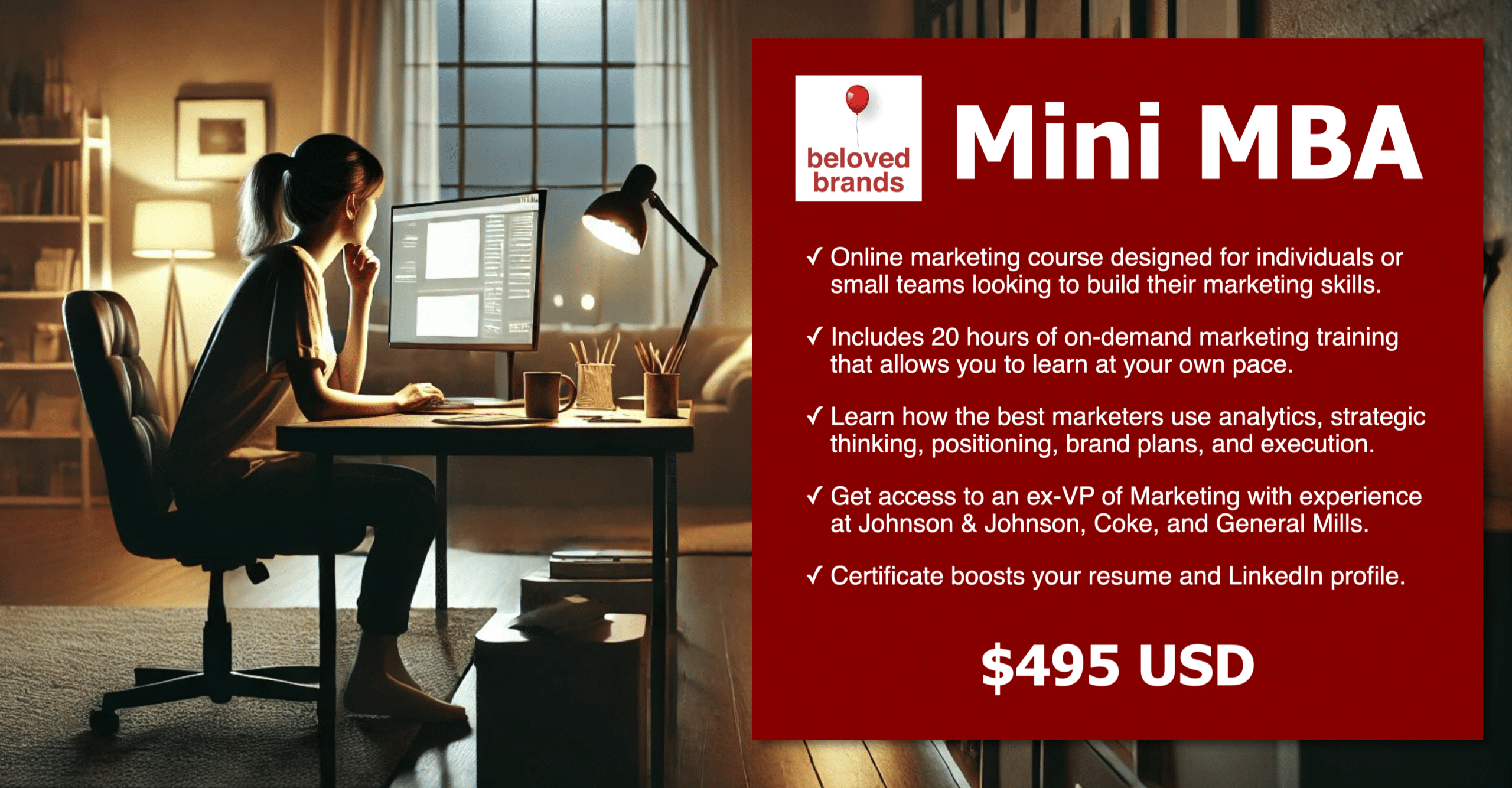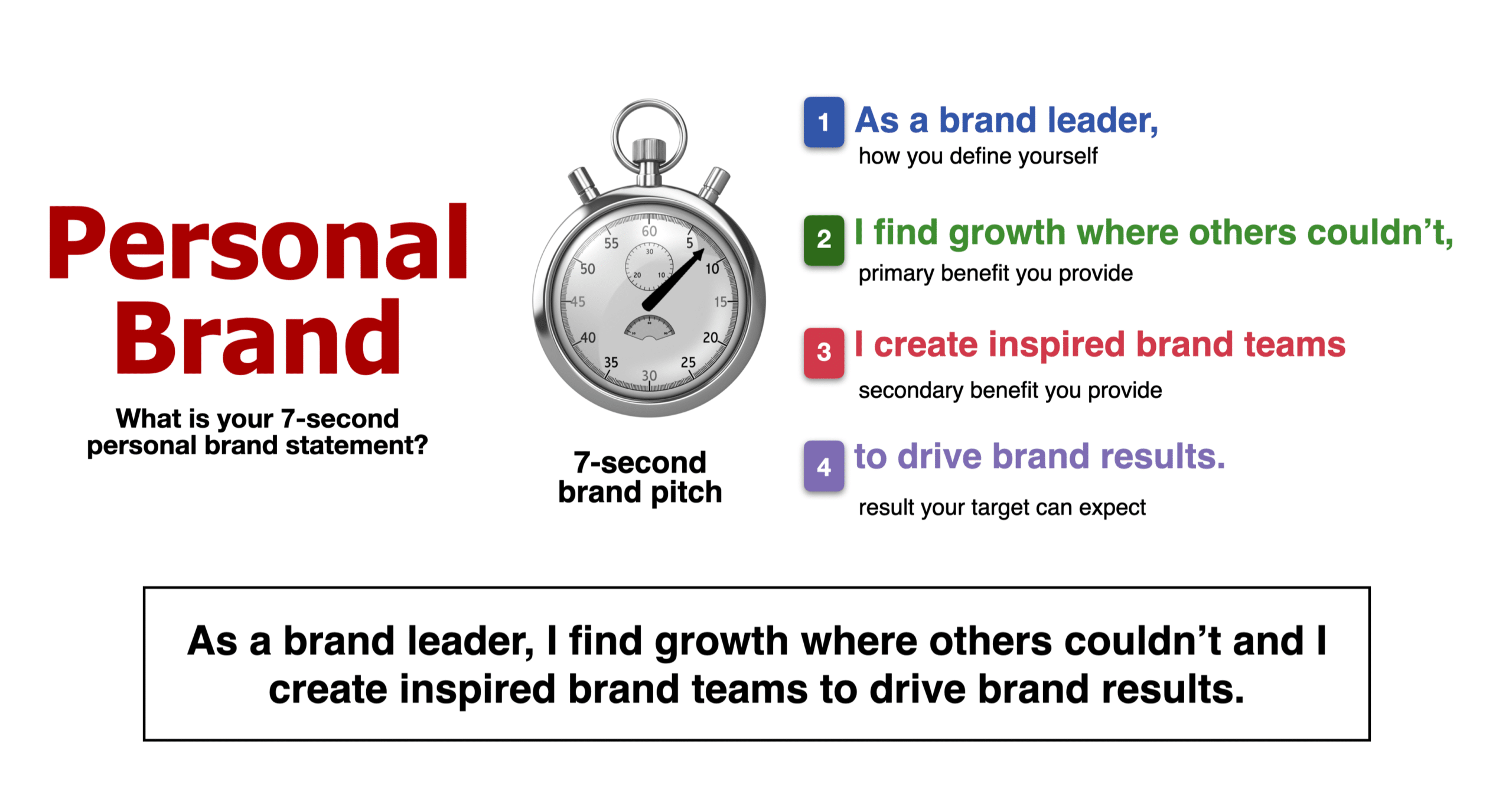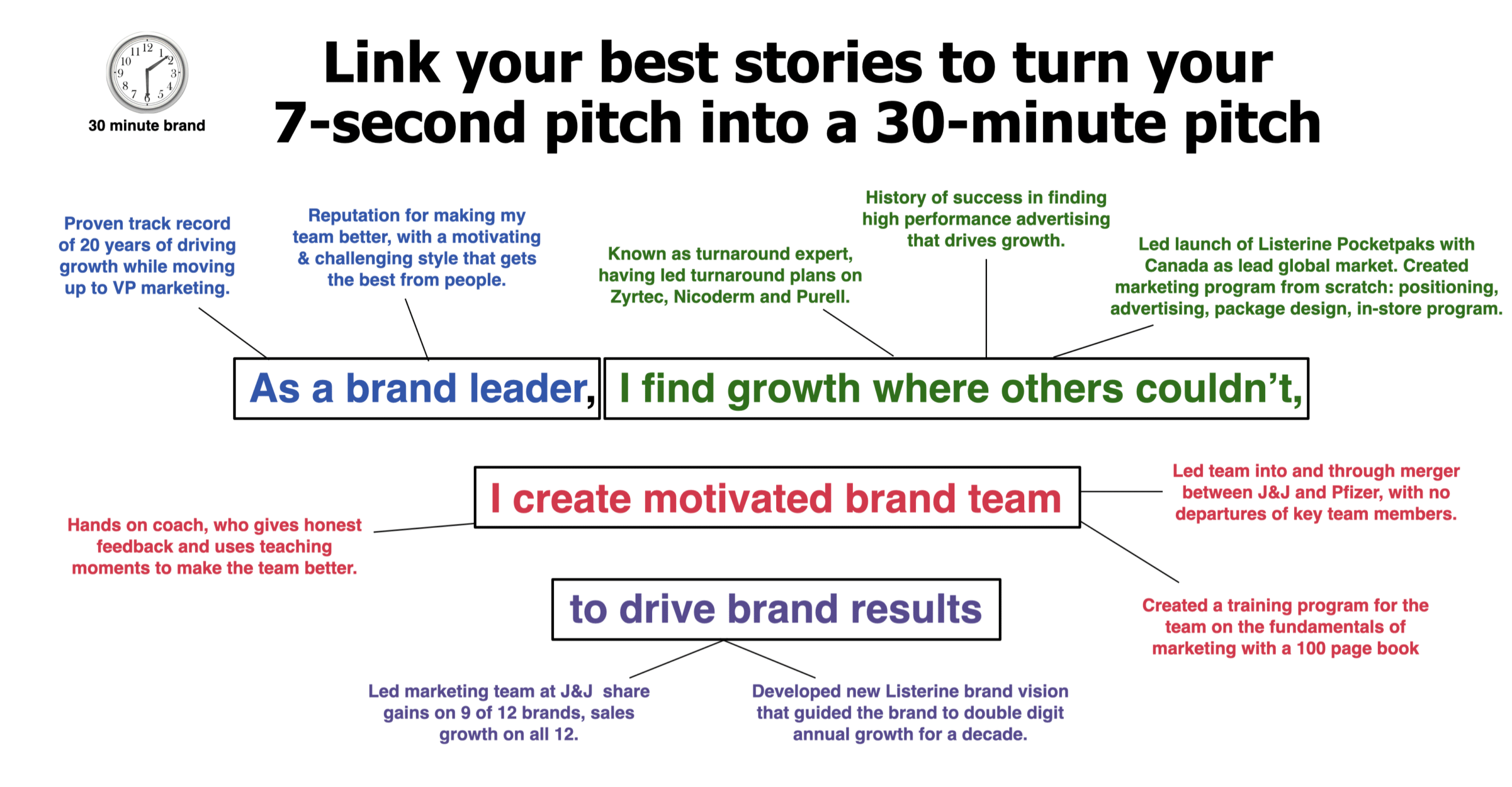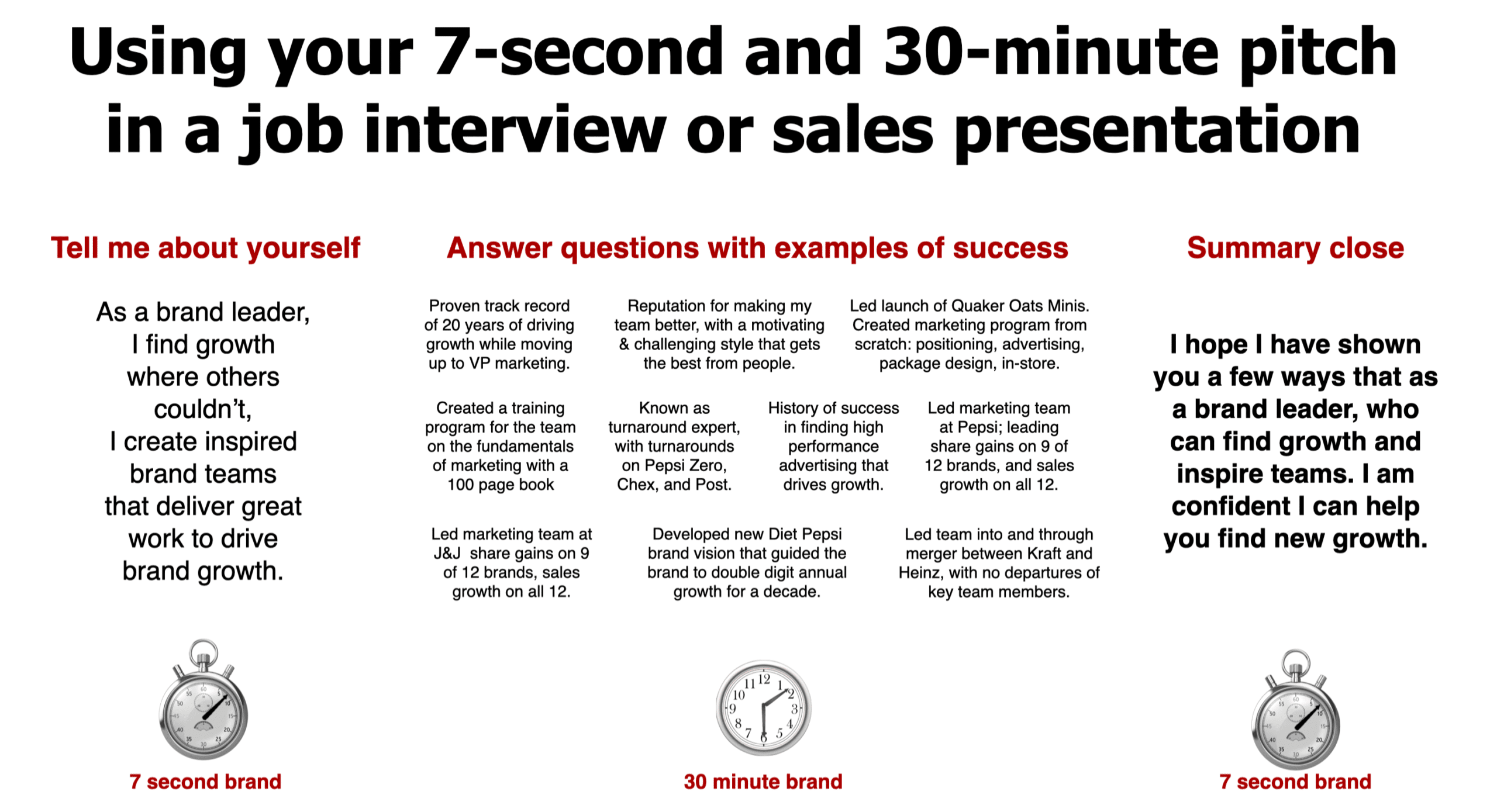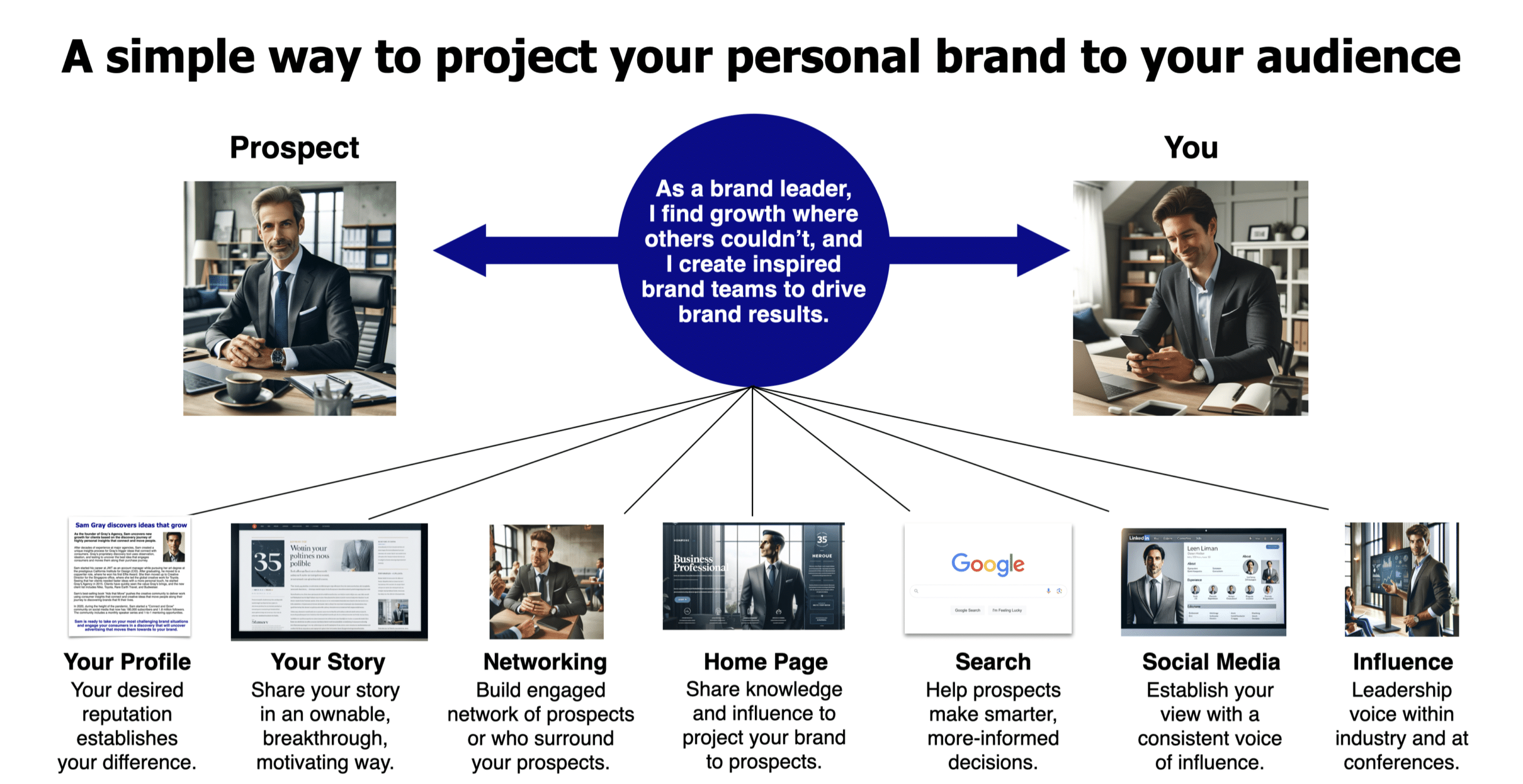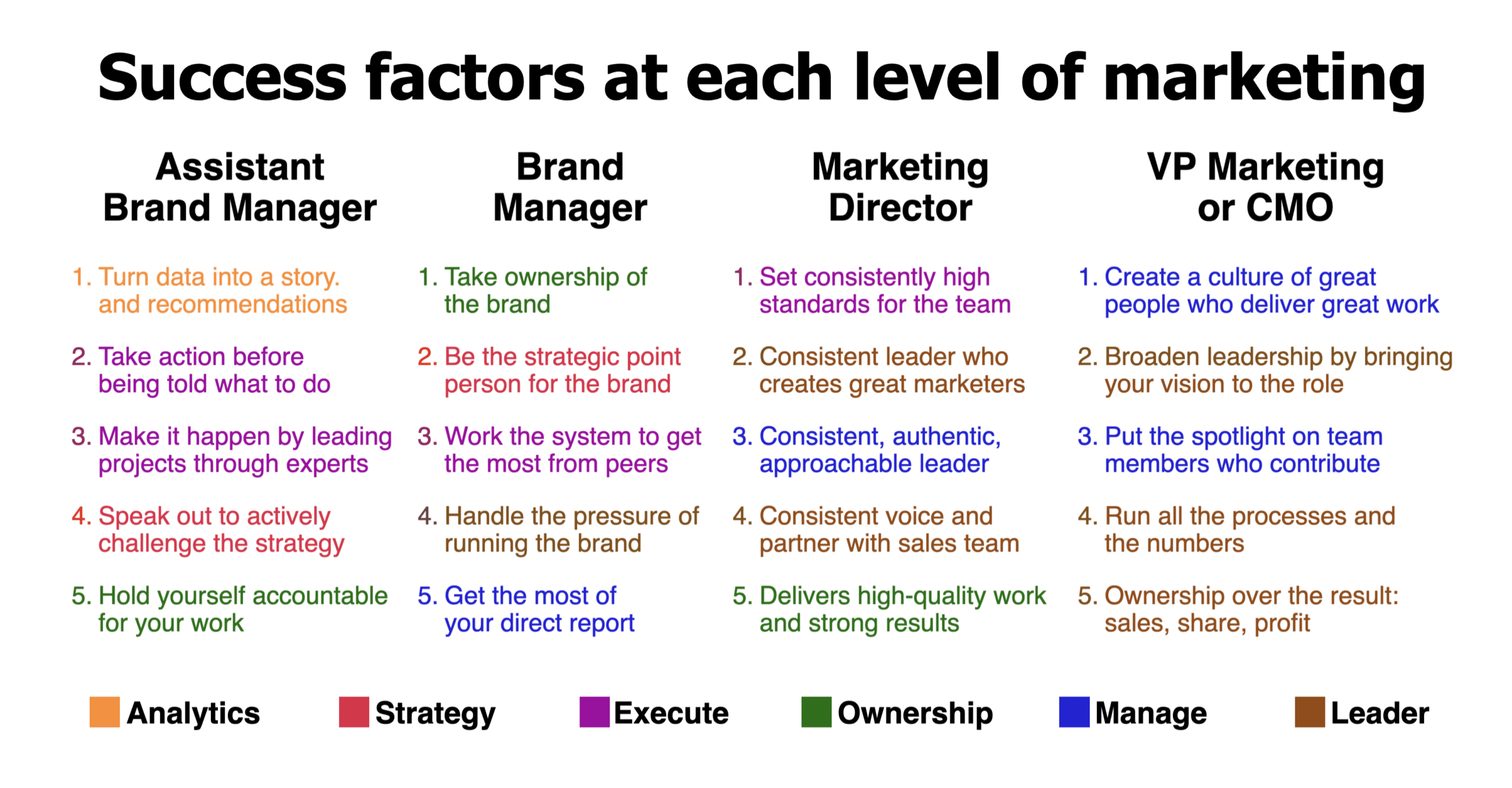As you manage your career, you need to use your personal brand statement to manage your reputation before others define who you are. If you do not define your reputation, then you run the risk of the possibility that others will define you. And you might not like it. One of the most frustrating things I experienced was short-sighted people who attempted to define me. “You are a CPG marketer” or “you are a creative marketer, or you lack this experience or that industry. I took control and defined myself with how I wished to see myself in the future.
Personal brand
What is your 7-second personal brand statement?
A typical marketing job interview starts with you waiting in the lobby longer than you wanted. Then the big introduction, the handshake, that awkward small-talk on the way to the tiny little room where all you can think to talk about is the weather or you find a great parking spot. Then you sit down, and outcomes that dreaded question, “So, tell me about yourself.”
Oh god we all hate that question. “Ummm, let me see, I like basketball, walks in the park and I think I’m rather funny, or at least my wife does.” Wow, bad start.
Then you get asked a series of 8-10 questions like “tell me a time when…”. And finally, they end the interview with, “Anything else to add?” You say, “No, it’s all good.” Then there is that awkward walk back to the reception desk, where you talk about your plans for the weekend. Then you drive home and realize you forgot to mention your three most significant career accomplishments. Even though you are a marketer, you forgot to act like a marketer, and most importantly, you forgot to define and deliver your brand.
You have just blown your interview.
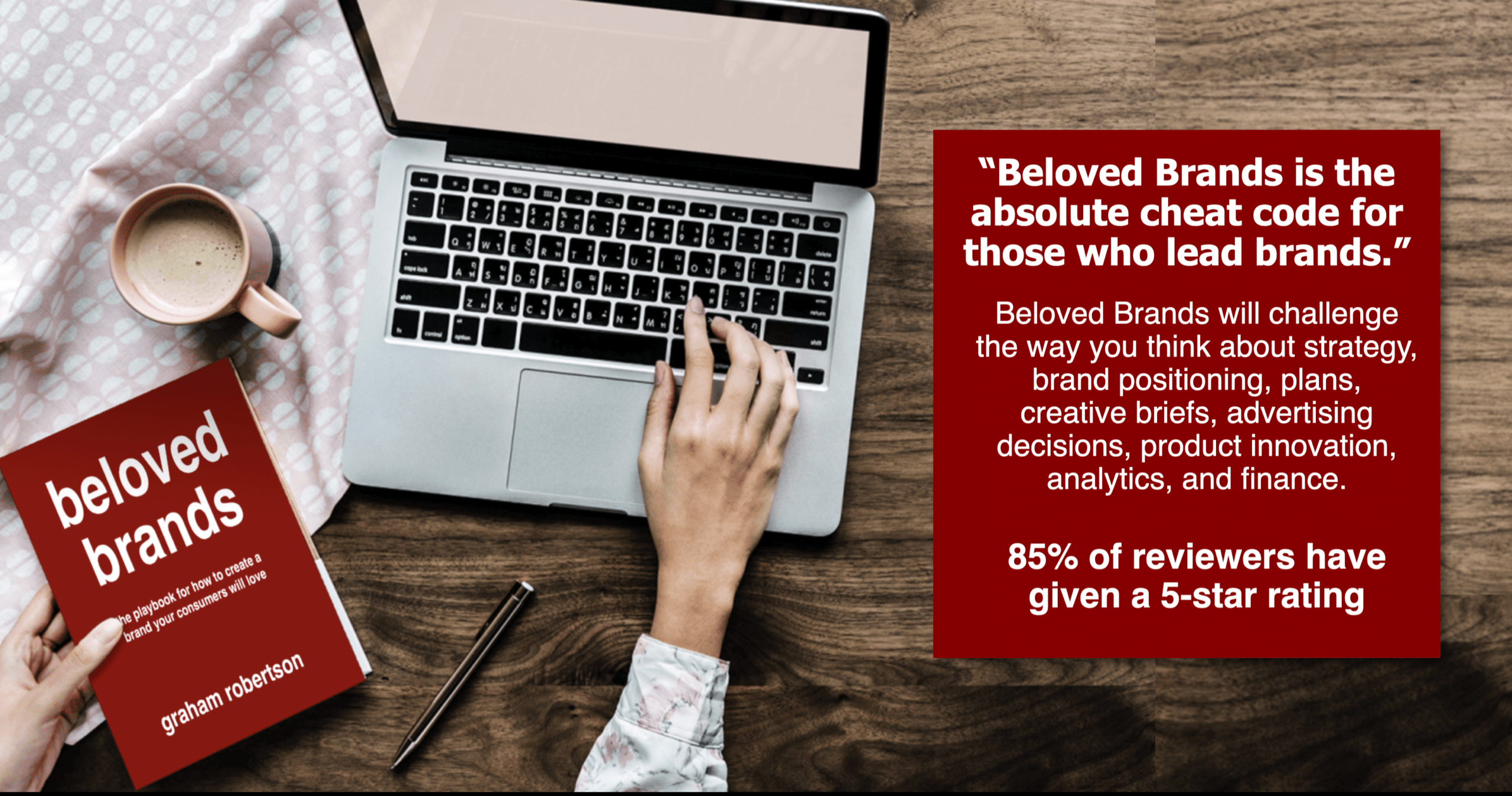
Tell me about yourself: Deliver your 7-second idea
“As a brand leader, I find growth where others couldn’t, and I create a motivated brand team that delivers great work to drive results.” Think of this like your 7-second personal brand statement, where you give a summation of your personal brand idea.
Four Questions to define your personal brand
- First, how do you define yourself, by where in the marketplace you see yourself having the biggest impact?
- Next, what is the primary benefit you provide your target, whether they are potential prospects?
- Then, what is the secondary benefit you provide your target, whether they are potential prospects?
- Finally, what is the expected result you deliver, that matches up to your target’s potential goals?
Brand idea brainstorm
Look at your resume and then start off by brainstorming as many options for each of the four areas as you can.
- Short definition
- Primary benefit
- Secondary benefit
- Expected result
Personal brand statement generator
To illustrate, click on the personal brand brainstorming effort above.
Brainstorm worksheet
This model is a great way to summarize yourself, based on what you have done over the last few years. Make sure your definitions are more forward-looking with an aspiration for what you want to be, not stuck in what you have been. Once you get that done, you can then begin to piece it all together and see what your own 7-second pitch might start to look like. Keep tightening that pitch until it flows.
Personal brand statement example
Nailing your 7-second personal brand statement
In my 20 years of CPG marketing, I became the turnaround guy, so “As a brand leader, I can find growth where others couldn’t” became my little hook I began to use. What is yours?
Once you feel comfortable with your 7-second pitch, take each of those four statement areas and try to come up with examples and stories from your past that can prove and demonstrate each element of the statement. These examples help define your 30-minute pitch, and enable you to tell your story in a more focused and expressive manner.
To illustrate, click on the personal brand statement above.
Personal brand statement
Building out your 30-minute brand story
Using these examples, you can any of the “so tell me a time when…” type questions. If these are your best 10 accomplishments, then you should refer to these to help demonstrate your brand idea. This is also a great page that you can be looking at when you are sitting in the reception area, just before your interview.
To illustrate, click on the personal brand above.
So here’s how the job interview should go:
- “So tell me about yourself”: Deliver your 7-second pitch.
- “Tell me about a time when you…”: Deliver any of the ten examples from your 30-minute pitch.
- “Anything to add?”: Repeat your 7-second pitch as the closing line.
To illustrate, click on how to use your personal brand in a job interview.
This way, you are now controlling up front how you want to define yourself. All 8-10 examples will help add to that definition. And as you get to the end, you want to use a 7-second close to re-affirm your big idea.
Later on, as the various interviewers re-group to discuss each person, you hope your big idea sticks in their head. “I like Bob because he could turn this brand around. He has done it before. He gets results”.
Lead with your 7-second personal brand statement
Use your 7-second personal brand statement at the top of your resume, your descriptor for your LinkedIn profile, your handshake introduction at networking meetings, or within the body of any emails that you send looking for jobs. The more you use it, the more you begin to make this your reputation.
Use your 30-minute personal brand pitch to fill out the examples on your LinkedIn profile and keep them at the tip of your tongue to be used as examples of your past, in how it lines up to deliver your personal brand idea.
Use your personal brand idea to establish consistency across every media choice you use
In today’s cluttered media world, use your personal brand idea to help organize all types of marketing communication efforts, including your brand story, sales material, networking, creating your own home page or blog, managing the search of yourself, portraying your personal brand through social media, and looking to establish yourself through any influence marketing.
When telling your brand story, you now have many media options available, including white papers, blog posts, LinkedIn updates, networking meetings or look to delivering presentations at industry events. Tell the same brand story, with consistent layers of brand messaging. There is nothing wrong with repetition, especially if you are using various media options to make it more engaging.
Be careful what topics (politics, sports, gossip) you decide to shoot your mouth off might feel therapeutic to you, but could damage your reputation longer term, not just with those who don’t share your views, but even those who do. They might feel you are toxic or alienating to be associated with. Creating your personal brand is hard. Staying on brand in the modern social media world is even harder.
Read our post on social media to see how to make the most of your online presence
To illustrate, click on how to project your personal brand above.
Best of luck to you as you manage your marketing career
Marketing Careers
On a classic marketing team, there are four key levels:
- Assistant Brand Manager.
- Brand Manager.
- Marketing Director or Group Marketing Director.
- VP Marketing or CMO.
To illustrate, click to zoom in on the brand management career pathway.
At the Brand Manager level, it becomes about ownership and strategic thinking within your brand plan. Most Brand Managers are honestly a disaster with their first direct report, and get better around the fifth report.
When you get to the Marketing Director role, it becomes more about managing and leading than it does about thinking and doing. To be great, you need to motivate the greatness from your team and let your best players to do their absolute best.
And finally, at the CMO level, you must create your own vision, focus on your people to make them better and shine, drive the business results, and run the processes.
Our Beloved Brands Marketing Training program will make your team smarter.
If you are running a marketing team, you will always benefit from having a smarter team. When you invest in our marketing training program, you will help your team gain the marketing skills they need to succeed. As a result, you will see them make smarter decisions and produce exceptional work that drives business growth.
We’ll work with your team to help them learn more about the five core marketing skills: Strategic Thinking, Brand Positioning, Marketing Planning, Marketing Execution, and Brand Analytics. Most importantly, your marketers will learn new tools, concepts, and ideas to trigger new thinking. To help their skills, we get participants to take each tool on a test run. Then, we give feedback for them to keep improving.
Strategic Thinking:
Our marketing training teaches brand leaders how to ask tough strategic questions to slow everyone down and engage in debate of options to move forward. To start, you will be given various tools to approach strategy in a thoughtful, analytical way. Importantly, marketers need learn how to change brain speeds to move from a strategic thinker style to uncover what is holding back a brand, and onto an instinctual thinker style on marketing execution.
We introduce our Strategic ThinkBox that allows marketers to interrogate their brand. Importantly, our ThinkBox pushes you to take a holistic look at the brand’s core strength, competitive landscape, tightness of the consumer bond, and business situation.
Brand Positioning:
Our brand positioning process teaches how to decide on the target market, consumer benefits, and reasons to believe. To start, you will learn to define the ideal consumer and frame the definition with their biggest needs, consumer insights and their enemy. Then, we provide our benefit cheatsheets to help learn how to discover the functional benefits and emotional benefits that a brand can deliver. Importantly, marketers need to make a decision on trying to stake out a unique space that is motivating to consumers, and ownable for the brand.
Learn to use our brand idea tool and see how it helps to communicate the brand idea to everyone across the organization. Finally, marketers will learn how to take the brand positioning work and translate it into a brand concept, brand story, and a brand credo.
Marketing Plans:
We see the marketing plan is a decision-making tool on how a brand will spend their limited resources. Moreover, the marketing plan communicates the expectations to everyone who works on the brand. Importantly, we teach marketers how to put together the vision, purpose, goals, key issues, strategies and marketing execution plans.
Learn how to write key issue questions and strategic statements that forms the foundation of the marketing plan. In addition, our marketing training provides various marketing planning templates including our one-page brand plan and ideal Marketing Plan presentation deck.
Marketing Execution:
Our marketing execution training starts with the concept of our Marketing PlayBox that matches up to the Strategic ThinkBox. To keep marketers on strategy throughout the execution stages, our Marketing PlayBox helps find in-the-box ideas that meet four dimensions: they are focused on our target, fit with the brand, deliver the message, and execute the strategy.
To start, we show how the creative brief sets up the PlayBox, serving as the bridge between the plan and execution. We go through the creative brief line-by line and give you examples of the best and worst. Importantly, you will learn to use our Creative Checklist to help make smarter decisions on creative communications. We workshop how to give feedback to your agency based on gaps you see with the checklist.
Learn to make media decisions that match up to your consumer’s purchase journey. In addition, we provide a similar Innovation Checklist to compare innovation ideas.
Brand Analytics:
Our comprehensive brand analytics training teach brand leaders how to lead a deep-dive business review. We outline the best analytical thinking so you can become a well-rounded marketer.
Learn to look at the marketplace, consumer analytics, channels of distribution, competitors or other brands in their industry. And, learn assess the brand itself. Importantly, you will learn how marketing funnels can help assess the brand’s performance. We provide 64 analytical questions that marketers can ask of their brand. Finally, we show how to understand the financial performance indicators of the brand.
Our training looks at three specific streams; Consumer Marketing Training, B2B Marketing Training, and Healthcare Marketing Training. With each program, all the of the examples are tailored to the type of marketer. Undoubtedly, we believe marketers will be at their best when the can see the concepts or tools working on their type of brand.
Take a look at our Marketing Skills assessment tool to see how you or your marketing team measure up.
For more information on our Beloved Brands Marketing Training programs, click below or email Graham Robertson at Graham@beloved-brands.com


